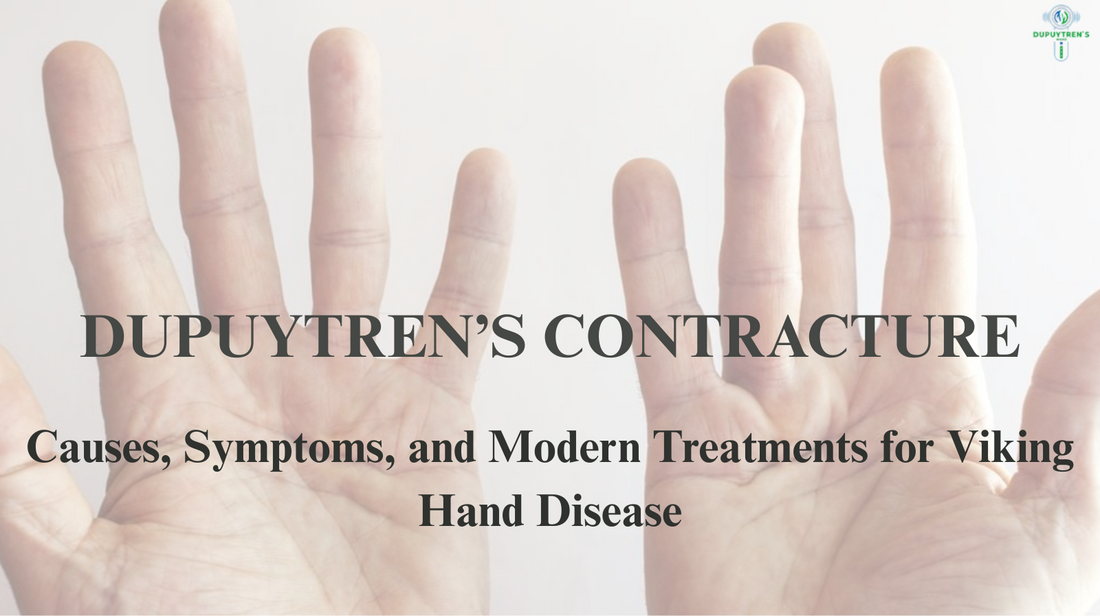
Dupuytren’s Contracture: Causes, Symptoms, and Modern Treatments for Viking Hand Disease
Share
Dupuytren’s contracture, often called Viking hand disease or Dupuytren’s Viking disease, is a condition that quietly affects millions worldwide, particularly those with European ancestry. Though the name may sound like something from history books, this disorder remains a modern challenge that can impact daily living, work, and quality of life. Understanding the latest insights on its causes, symptoms, and treatments can help those affected make informed choices.
What Is Dupuytren’s Viking Disease?
Dupuytren’s contracture is a progressive hand condition where the connective tissue beneath the skin of the palm thickens and tightens. Over time, this causes one or more fingers—most often the ring and little fingers—to curl inward toward the palm. Unlike arthritis, the joints themselves are not initially damaged, but the loss of flexibility can interfere with gripping objects, typing, or even shaking hands.
The condition is sometimes called Viking hand disease because it was historically most common among people of Northern European descent. Genetic studies support this link: certain inherited traits increase susceptibility, making the nickname more than just folklore.
Early Signs and Symptoms
The disease typically progresses slowly, sometimes over years. Early detection can make a big difference in managing symptoms. Common early signs include:
- Small, firm lumps or nodules in the palm.
- Rope-like cords of tissue forming under the skin.
- Difficulty placing the hand flat on a table (the “tabletop test”).
- Gradual bending of one or more fingers toward the palm.
At first, Dupuytren’s Viking disease may cause no pain. However, as the condition progresses, the functional impact can become frustrating and limit independence.
Causes and Risk Factors
While the exact cause remains unclear, researchers have identified several contributing factors:
- Genetics: A strong family history is the most significant risk.
- Age and Gender: Most common in men over 50.
- Ancestry: People of Northern European descent are at the highest risk.
- Lifestyle Factors: Smoking and heavy alcohol use may worsen the condition.
- Medical Conditions: Diabetes, epilepsy, and certain medications are linked with higher risk.
Unlike injuries or repetitive strain, Dupuytren’s Viking disease develops internally, without a clear external trigger.
Modern Treatment Options
The good news is that treatment for Viking hand disease has advanced far beyond traditional surgery. Today, options range from minimally invasive techniques to outpatient procedures:
1. Collagenase Injections (Xiaflex):
This FDA-approved enzyme breaks down the thickened collagen cords in the palm. It’s injected directly into the tissue and followed by a manipulation procedure to release the finger. Recovery is typically faster than surgery.
2. Needle Aponeurotomy (Percutaneous Fasciotomy):
A tiny needle is used to puncture and weaken the cord, allowing the finger to straighten. It’s a quick, office-based procedure but may have higher recurrence rates.
3. Surgical Fasciectomy:
In more advanced cases, surgery may be required to remove the affected tissue. While this can provide longer-lasting results, recovery involves physical therapy and carries a higher risk of complications.
4. Radiation Therapy:
In very early stages, low-dose radiation may slow or halt the disease’s progression by reducing cell activity in the palm.
5. Emerging Research:
Studies are exploring stem cell therapy, gene-based treatments, and biologic drugs aimed at targeting the underlying disease process rather than just the symptoms.
Living with Dupuytren’s Viking Disease
Though treatment is effective, recurrence is common, and many people require multiple procedures over their lifetime. Lifestyle choices—such as avoiding smoking, managing diabetes, and doing gentle stretching—may help slow progression. Hand therapists also play a key role in recovery, teaching exercises that maintain flexibility after treatment.
Perhaps the most important takeaway is that Viking hand disease is not a rare curiosity—it’s a common, manageable condition. Greater awareness and early medical consultation can prevent minor symptoms from becoming major limitations.
FAQs About Dupuytren’s Viking Disease
1. Why is Dupuytren’s contracture called Viking hand disease?
Because the condition is historically common in Northern European populations, especially those of Viking descent, it earned this nickname.
2. Is Dupuytren’s Viking disease hereditary?
Yes. Genetics play a strong role, and people with family members affected are more likely to develop it themselves.
3. What is the difference between Dupuytren’s and trigger finger?
Trigger finger involves tendons locking or catching, while Dupuytren’s affects the connective tissue in the palm that causes fingers to bend.
4. Can Dupuytren’s contracture go away on its own?
No. Once the tissue begins thickening, it rarely regresses. However, progression can be slow, and early intervention helps.
5. How long is recovery after Dupuytren’s surgery?
Recovery can take weeks to months, depending on the procedure and severity. Physical therapy is often recommended for best results.
6. Is non-surgical treatment effective?
Yes. Collagenase injections and needle aponeurotomy are effective options, especially for patients who wish to avoid major surgery.
7. Can exercises or home remedies cure Viking hand disease?
Exercises can help maintain mobility and strength, but they cannot cure the condition. Medical treatment is required to release contracted fingers.
Final Thoughts
Dupuytren’s Viking disease may sound like a relic of the past, but it continues to affect modern lives in very real ways. With earlier diagnosis, less invasive treatments, and ongoing research, there is more hope than ever for people dealing with this condition. If you notice early signs—such as lumps or cords in your palm—it’s wise to consult a hand specialist before the disease limits your daily activities.
